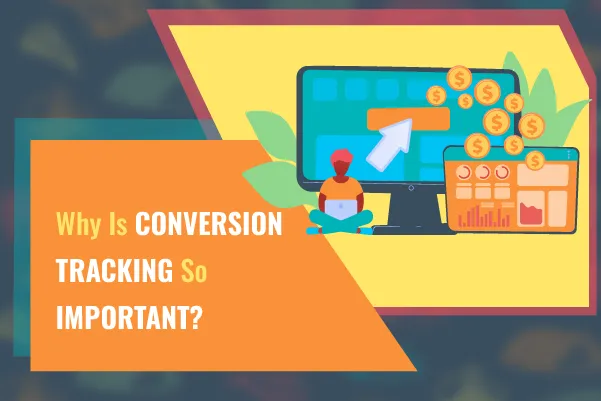Marketing and Growth
Get proven, real-world marketing trends, tips, and tricks to power up your online marketing strategy, so you can generate more traffic and boost even more conversions for maximum growth.

Why Is Conversion Tracking So Important?
Conversion tracking is the process of measuring and analyzing the actions that users take on a website in order to determine which of them lead to a desired outcome, typically a sale or a lead. It can be used to track a variety of different user actions, such as filling out a form, purchasing a product, signing up for a newsletter, or downloading a file.
By tracking these actions, website owners can identify which marketing channels and campaigns are generating the most conversions and optimize their efforts accordingly. Conversion tracking is often used in conjunction with advertising platforms like Google Ads or Facebook Ads in order to measure the effectiveness of ad campaigns.
Why is conversion tracking important? Because it ensures that advertisers and ad networks understand the source of an install or purchase (or any other data point), which helps determine the quality of the source. It also provides a better understanding of campaign performance for future optimization.
However, more often than not, conversion tracking is not set up properly, and it can lead to different issues ranging from mild to severe. Some of the most common ones are:
1. Low conversion rates: When conversion tracking is not set up correctly, it can lead to inaccurate data, which makes it difficult for marketers to determine what is working and what is not.
2. Poor ROI: If you are not tracking conversions accurately, you may be wasting money on ad campaigns that are not delivering a good return on investment.
3. Inaccurate attribution: Conversion tracking helps to accurately attribute conversions to the marketing channel or campaign that drove them. Without proper tracking, it can be difficult to know which campaigns are driving sales or leads.
4. Unoptimized campaigns: Without accurate conversion tracking, it is difficult to optimize your campaigns for maximum results. This can lead to poorly performing campaigns and a lower Return on Advertising Spend (ROAS).
5. Difficulty in measuring success: If you are not tracking conversions properly, it can be difficult to measure and quantify the success of your advertising and marketing efforts. This can be particularly problematic if you are trying to justify your marketing spend to management or stakeholders.
What can cause conversion tracking not to be set up correctly?
There are several reasons why conversion tracking may not be set up correctly. One common issue is an improperly implemented conversion tracking tag or code, which is the piece of code that is installed on your website to track conversions.
It can also be that you are not tracking the right metrics. It's important to ensure that you are tracking conversions that are relevant to your business goals and that you have set up the right conversion actions in your account. Additionally, if you have low conversion rates or no conversion data, this could indicate a problem with your ad targeting, landing page, or offer.
Other factors that can affect conversion tracking include issues with your website's code, problems with your server or hosting provider, or issues with the interface you are using. To troubleshoot these issues, it's important to work with a qualified web developer or ads specialist to identify the root cause of the problem and implement a solution.
How can you set up conversion tracking?
There are several different ways to set up conversion tracking, depending on the platform you're using. Here are some examples:
1. Website tracking pixel: Many advertising platforms use a tracking pixel, which is a small piece of code that you place on your website. This pixel tracks user behavior, such as clicks and page views, and reports back to the advertising platform. You can use this to set up conversion tracking and see which ads are generating the most conversions.
One of the most used tracking pixels is the Facebook Pixel (or Meta Pixel). When a user interacts with your website, the Facebook Pixel can track their activity, such as product purchases, form submissions, and other actions that you define as conversions. This information is then sent back to Facebook, where it can be used to measure the effectiveness of your Facebook Ads campaigns and improve the targeting of your ads.
2. Code snippets: Some platforms will provide you with a code snippet that you can embed directly into your website or app. This code will track user behavior and send that data back to the platform for analysis.
Google Analytics, for instance, uses code snippets. It is a service that allows you to track a variety of online activities, including website visits, e-commerce transactions, and social media interactions. You can also track the performance of your advertising campaigns, such as Google Ads and other paid search campaigns, to help you understand which campaigns are driving the most conversions and traffic.
3. Google Tag Manager: Google Tag Manager allows you to manage and deploy marketing tags. These can be tracking pixels and code snippets on your website, and the process can be done without needing direct access to the source code. This can be an easy way to set up conversion tracking across multiple platforms without needing a developer.
4. Direct integration: Some platforms may have direct integrations with your website or app that allow for easy setup of conversion tracking. For example, if you use a CRM like Salesforce, you may be able to set up conversion tracking by simply linking your Salesforce account to your advertising platform.
Regardless of the method you choose, it's important to ensure that your conversion tracking is configured properly and that you're accurately tracking the actions that matter most to your business.
What type of events can you track to measure conversions?
There are three ways to track conversions with tracking pixels:
1. Standard Events: Standard events are predefined events that are already set up in the tracking pixel. These events include add-to-cart, purchase, initiate checkout, and more. By using standard events, you can track the most common actions that users take on your website.
2. Custom Conversions: Custom conversions are a type of event that you can set up to track specific actions that are important to your business. For example, if you want to track when someone fills out a lead form on your website, you can set up a custom conversion for that action. Custom conversions allow you to track the exact events that matter most to your business.
3. Custom Events: Custom events are similar to custom conversions in that they allow you to track specific actions on your website. However, custom events offer more flexibility than custom conversions because you can define the event parameters yourself. This means that you can track a wider range of actions and behaviors on your website, such as clicks on specific buttons or interactions with specific elements on your site.
We understand that all of this may sound incredibly confusing to you, which is why we recommend our Caviar conversion tracking and troubleshooting service, an elegant solution for conversion tracking. Our team of experts will help you calculate ROAS and ROI for your brand for the following platforms: Google Analytics, Google Ads, and Google Tag Manager. Let's get the most out of your ad campaigns!
About Us
10777 Westheimer Road, Ste 1100, Houston, TX 77042
PalmPons is a marketing support platform, where business owners can order marketing services, circumventing the process of vetting and hiring freelancers, employees or agencies. Our founders are freelancers graduates with over 40,000+ hours of digital marketing experience (that’s over 14+ years). We love data, we love results and we love making impossible things possible. Come say hi.
© 2022 PalmPons. LLC. All Rights Reserved


